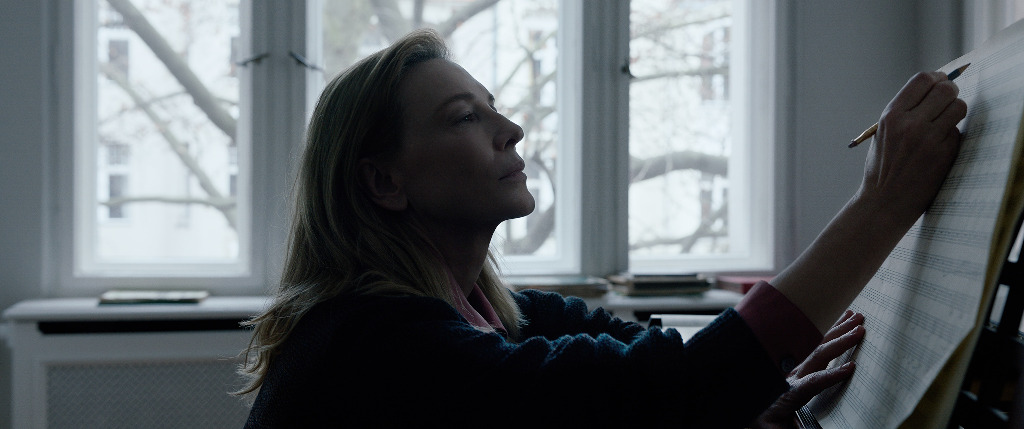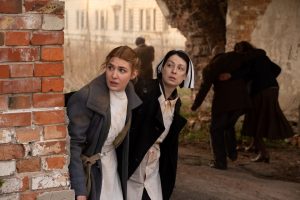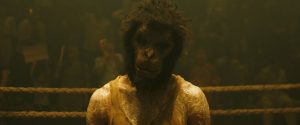Reviews include Irena’s Vow, The Beast, and Before I Change My Mind.
TFCA Friday: Week of Oct. 14
October 14, 2022

Welcome to TFCA Friday, a weekly round-up of film reviews and articles by TFCA members.
Remembering Jeff Barnaby

At The Globe and Mail, Kelly Boutsalis remembers iconoclastic Mi’kmaq filmmaker Jeff Barnaby, who broke barriers by deftly infusing the horror genre with tales of Indigenous resistance in films like Blood Quantum, Rhymes for Young Ghouls, short films, and other works. “I’m truly thankful that Barnaby was able to create what he did with the time that he had. He has left us with the many indelible images he put to screen, which include Devery Jacobs in Rhymes for Young Ghouls, in a gas mask and hooded leather jacket, with her hair in braids, ready to take down a corrupt Indian agent in the 1970s-set film. Or Blood Quantum’s stare-down between Kiowa Gordon’s troubled character Lysol and a zombie in a helmet, a mirror of the real-life photograph of a Mohawk protester and a member of the Canadian military,” writes Boutsalis. “Rhymes for Young Ghouls was wildly ahead of its time, depicting a deadly and depraved version of Canadian residential schools that most Canadians weren’t aware of yet.”
In Shiny Things, Norm Wilner reflects on a distinctive voice that made a mark: “Jeff was one of those rare filmmakers who functioned almost exclusively on intuition, charging forward into a project and trusting he’d be able to shape it into an organic entity in post-production,” writes Wilner. “It gave his films a messy and sometimes wobbly feeling – Rhymes for Young Ghouls has some supporting performances that do not fit the picture’s tone at all, and Blood Quantum has more ideas bouncing around inside it than it can comfortably hold. But from moment to moment, those movies play, and there’s never any question as to who’s behind the camera. I’d compare him to Terrence Malick, but he’d be annoyed by the comparison; couldn’t I pick someone cooler?”
Chris Knight at the National Post looks at the work and legacy that Barnaby leaves behind: “He added that he was at work on a ‘cosmic horror road movie’ to be called The Old Breed,” writes Knight. “We will never see that film as Barnaby would have made it, but given the recent resurgence in First Nations genre films that he helped usher in – Danis Goulet’s science-fiction tale Night Raiders, for instance, and the deliciously lo-fi Slash/Back from Nyla Innuksuk – it’s likely his spirit will infuse something similar in the near future.”
In Release this Week
All Quiet on the Western Front (dir. Edward Berger)
“From the ferocious opening of the film to the meditative last few minutes, Berger is decisive and in control of the film from the macro to the micro. Switching between a blue-tinted palette for the front and warm tones used in scenes with the officers, Berger draws a strong distinction between the pawns used in war and the men moving them across the board,” notes Rachel Ho at Exclaim!. “He captures some truly exquisite shots that acknowledge the breadth and unforgiving nature of the Western Front. Furthermore, Berger is unapologetic in his depiction of the violent tragedy of war and doesn’t pull any punches when showing the merciless and barbaric physicality and weaponry used.”
“Two other versions of Remarque’s novel are out there and this one, the most expensive German film in the history of Netflix offers a graphic, truthful, modern take that will shake seen-it-all audiences to the core,” writes Anne Brodie at What She Said. “A heavy drum score of doom underscores the tragedy of war from the moment the boys joyously sing that they will fight for the Fatherland, through to the devastating, painful end. Essential viewing for mature audiences with the warning STRONG BLOODY WAR VIOLENCE.”
“Ultimately, it is Berger’s handful of anachronistic touches that lend his All Quiet on the Western Front its most spectacularly haunting moments,” observes Barry Hertz at The Globe and Mail. “There is his expert blending of computer and practical effects for the battle scenes – allowing for cruelly inventive new ways to destroy the human body – as well as a pounding three-beat synth score by Volker Bertelmann that constantly keeps the audience on edge and prepared for the absolute worst. Which is a reality, as the film reminds us until its very final second, that could arrive at any moment.”
“In All Quiet on the Western Front, the killing doesn’t stop, even when it’s supposed to. It’s two-and-a-half hours of inhumanity writ large,” says Jim Slotek at Original Cin. “Which is as it should be, I suppose. War movies as pure entertainment sometimes seem inappropriate so long as real wars exist. All Quiet on the Western Front exists to make the viewer uncomfortable – infinitely preferable to what the characters endure.”
“While Berger admirably nails all the details in recreating the inhumanity of trench warfare—the production design, costumes, and make-up are marvels of gritty authenticity, while the appropriately cold cinematography captures a barren wasteland—the moral complexity of this tale makes it especially memorable,” writes Pat Mullen at That Shelf. “Hollywood movies often tell war stories from the heroes’ perspective. German’s legacy with the Great War is far more complicated. Capturing the scale and spoils of the war, the film acknowledges this inheritance sombrely and matter-of-factly, eulogizing all the lost lives. It’s only fitting that a German film should be the definitive adaptation of All Quiet on the Western Front.”
The Curse of Bridge Hollow (dir. Jeff Wadlow)
“The Curse of Bridge Hollow is a pleasant enough family watch and is given a fair and not a poor rating as it succeeds at what it is aimed to be, a comedy horror for the family, an entertaining but somewhat bland one,” admits Gilbert Seah at Afro Toronto.
Falcon Lake (dir. Charlotte Le Bon 🇨🇦)
“Directed and adapted from a graphic novel by actor-turned-filmmaker Charlotte Le Bon, Falcon Lake is seasoned with tropes of the horror genre – power outages, lightning storms, and some mild jump scares in the opening scenes. There’s even a poster of Psycho on the bedroom wall,” writes Chris Knight at the National Post. “But ultimately, the story is more grounded in drama than the supernatural.”
“Actor turned director Charlotte Le Bon equates teen sexuality with horror film tropes — and all hail that creative impulse,” says Peter Howell at the Toronto Star. “Joseph Engel and Sara Montpetit find steam and suspense in the titular Quebec lake, where ghosts wander and hearts get bruised in 16-mm splendour. A gem of mood and technique, it’s the most impressive work by a first-time Canadian feature director I’ve seen this year.”
“Falcon Lake takes a premise and themes familiar to those well versed in national cinema and offers clever, intelligent variation,” writes Andrew Parker at The Gate.
“The night scenes and dark cinematography (along with almost meta scenes of teens in the water, giddily pretending to be attacked by the ghost), suggests repeatedly that something bad is going to happen. And eventually, inevitably, it does. But at that point, it is almost an afterthought to the richness of a young relationship we’ve watched shakily rise and fall,” writes Jim Slotek at Original Cin. “Le Bon self-assuredly strikes a mood in Falcon Lake, one that she maintains throughout. There is not a false note in the movie, as both Montpetit and Engel create characters that mesh believably. It’s a debut the director can be proud of.”
“Nothing much else happens but need not,” admits Gilbert Seah at Afro Toronto. “Falcon Lake is beautifully photographed with haunting music. One can enjoy the film Falcon Lake as lazily as just resting and rejuvenating by a lake beach.”
Halloween Ends (dir. David Gordon Green)
“Know from the start: Halloween Ends has some of the best kills in the franchise,” advises Thom Ernst at Original Cin. “The task facing Halloween Ends isn’t just to successfully stand on its own but to wrap up the trilogy properly while respecting the originators. To the latter, Halloween Ends tips its blade to Carpenter’s films, Halloween, and beyond. How weird is it when a character being skewed to the wall so that their feet dangle off the ground can bring back such a feeling of nostalgia?”
“It takes some time for Myers to shift into attack mode and for the inevitable confrontation with Laurie to occur. The film focuses on Corey’s story, which is the antithesis of a boy-meets-girl rom-com as it violently demonstrates how dark impulses, once acted upon, can spread like the most virulent of contagions. Green makes the gloom all the more tangible with intense close-ups and jump scares and a soundtrack laced with hard rock and punk nihilism,” writes Peter Howell at the Toronto Star. “It’s a risky move by Green and his co-writers to turn our attention away from the main Halloween combatants. It’s a clever one, though, and to go by the repeat applause I heard at a public preview screening, it’s likely to go down well with fans of the franchise.”
“[W]hile the trailers seemed to promise two hours of smackdown between the killer and Curtis, the reality is more varied in tone and pacing, thank heavens,” notes Chris Knight at the National Post. “Not that there isn’t also plenty of gore to go around. Between bullying, retribution, vigilantism and straight-up serial killing, we get an assortment of mangled bodies, stabbed faces and one de-tonguing.”
“Bolder than anyone expects yet another ‘final’ entry in a horror franchise to be, David Gordon Green’s Halloween Ends is bound to divide opinion, and in this case, that’s probably a great thing,” says Andrew Parker at The Gate.
“Curtis gives a performance that reminds us why she is a powerhouse,” writes Marriska Fernandes at Exclaim!. “There are two scenes where she crushes the fiery dialogue and it will forever be some of my favourite Laurie Strode moments from this trilogy. While in the previous two films Laurie was traumatized and revengeful, now that she has moved on, Curtis can relish the lighter side of the role, reminding viewers she has impeccable comic timing, too.”
The Loneliest Boy in the World (dir. Martin Owen; Oct. 18)
“It is difficult not to like a film that is dedicated to the memory of the puppy that is featured in the film,” says Gilbert Seah at Afro Toronto.
Plan A (dir. Doron Paz, Yoav Paz)
“Filmmaker brothers Doron and Yoav Paz reveal a personal history from a Holocaust survivor in Plan A, the true story of a cell of Jewish underground resistance members that fought back post-WWII in Berlin,” notes Anne Brodie at What She Said. “The Brigade members search their souls in this intense look back at upheaval and unrest in post-WWII Germany.”
“Plan A achieves its purpose of reminding the world of the horror of themes killing of innocent Jews in the concentration camps and that the only true revenge is to show the enemy that an eye for an eye, a tooth for a tooth is not the way to go,” writes Gilbert Seah at Afro Toronto.
Rosaline (dir. Karen Maine)
“The performances, though perhaps somewhat rooted in caricature, are nevertheless committed and note-perfect, especially Dever as the cynical but whip-smart ex, Allen as the doe-eyed doofus pursuer, and Merced as the sweet but simple cousin who learns the hard way that one must be very careful what one wishes for,” writes Kim Hughes at Original Cin. “Most of the comedic heavy lifting falls to Rosaline’s female characters, including briefly but exceptionally Ladies Capulet and Montague — eye-rolling as their husbands pointlessly swagger and strut — as well as Driver in a small but scene-stealing role as the droll nurse who knows everyone’s secrets.”
She Will (dir. Charlotte Colbert)
“The film progresses at a pondering pace, with mudded sub plots, though the visuals, astounding that they may be, do not help much in keeping the audience’s attention,” sighs Gilbert Seah at Afro Toronto.
Stars at Noon (dir. Claire Denis)
“Combine Denis’ listless and scattered approach with a pair of mismatched leads and some unnecessary modern updates, and Stars at Noon amounts to a curious misfire that even her most ardent admirers will have trouble defending with any degree of conviction,” argues Andrew Parker at The Gate.
“Denis’s point of view is atmospheric and emotional: we’re made to understand a decaying and corrupt society—from cops to cab drivers—which has been bought and sold, leaving the people upset but incapable of making a change,” notes Marc Glassman at Classical FM. “The underlying hysteria in Trish [Margaret Qualley] may in part be due to her appreciation of the difficult reality of a population that she has come to enjoy with the exception of a corrupt policeman (Danny Ramirez) who exploits her whenever he can.”
“But with some reflective distance, away from the snap judgment of festivals, Stars at Noon proves a pretty interesting film, if a sometimes confusing one,” admits Liam Lacey at Original Cin. “Denis is clearly about upending expectations, taking the thriller tropes and drawing them back to her own areas of concern: colonialism, the complexity of erotic relations and gender roles.”
Summit Fever (dir. Julian Gilbey)
“Summit Fever, with some exciting with cliffhanging suspense, unfortunately struggles from the clichéd baggage carried by the various climbers that director Gilbery pads his film with,” admits Gilbert Seah at Afro Toronto.
Tár (dir. Todd Field)
“The fact is that you probably don’t make a movie like Tár if you aren’t interested in nuance, and the film, for all its provocations, isn’t necessarily trying to corner or end the argument at its center,” argues Adam Nayman at The Ringer. “One potentially uncharitable view is that, by foregrounding a queer woman as its example of a monstrous creator, Field is jerry-rigging a glamorously edgy effigy to take the heat off the same male establishment Lydia Tár is so eager to speak up on behalf of (imagine if the protagonist had been a two-fisted, toxic auteur à la David O. Russell). There’s also a sense that in leaving the exact nature of Lydia’s transgressions ambiguous, the director is building in some wiggle room with which his antiheroine might be redeemed or reclaimed as a tragic case—a victim as well as a perpetrator.”
“Of course, Tár might have collapsed into itself were it not for Blanchett,” raves Barry Hertz at The Globe and Mail. “The actress – who by this point in her career is the acting world’s own Lydia Tár, minus, I presume-slash-hope, all that other stuff – lives and breathes this character. Prepare for the rest of the movie-going year to be taken up by slack-jawed amazement at how Blanchett studied classical musical technique from the ground up for this role, how she learned German, how she methodically cloaked herself in a life not her own. But all this backgrounds a performance that grips and lingers, seduces and destroys. Watching her is a thrilling, incomparable experience. All hail the maestro – everyone else is cancelled.”
“Todd Field has a lot of his mind for his first film in 16 years — classical music, cancel culture, betrayal, the demands of fame and ruthlessness of genius — which makes for a fidgety narrative and a disorienting watch. Fortunately he chose the essential and anchoring Cate Blanchett for the title role of Lydia Tár, a tornado of talent (she’s an EGOT, having won Emmys/Grammys/Oscars/Tonys) who excels at everything except the basics of humanity,” notes Peter Howell at Night Vision. “Lydia exudes entitlement and abuses the ‘robots’ around her, but she’s about to find out that karma is a beast, too. Blanchett is splendidly horrid in this spellbinding psychodrama; expect another ‘O’ for Lydia’s EGOT.”
“One of Field’s skills as writer/director is the way he manages to slowly deliver a litany of tics and peccadilloes that seem modest and unobtrusive individually, only to have them slowly build into an image of an ego in free fall. Take Lydia’s aversion to a colleague’s habit of clicking his pen, so intense she has to snatch it away from him. She also clamps her hand down on that Juilliard student’s restless leg,” writes Chris Knight at the National Post. “It all hinges on a virtuoso performance from Blanchett.”
“Todd Field’s Tár has the depth and artistry of a finely wrought tragedy. Every scene is finely measured to achieve the greatest possible effect,” says Marc Glassman at Classical FM. “The story of Lydia Tár wouldn’t be worthy of his effort if the conductor’s hard work and artistry wasn’t clear throughout the film. The music is brilliantly showcased, whether it’s Mahler’s Fifth or Elgar’s Cello Concerto. And the original compositions by Oscar winner Hildur Guðnadóttir fit in superbly. As for Cate Blanchett, her performance is impeccable.”
“The performance is a masterclass in subtlety and nuance. Blanchett is a formidably talented actor who throws herself into her roles with commitment,” observes Karen Gordon at Original Cin. “For this film, for instance, she learned to play piano, conduct credibly, and to speak some German, all of which contributes to the veracity of her projects. To my taste, there are drawbacks to her exacting style. Blanchett’s precision of craft can come across as too actorly at times, with a too-obvious technique that can give her characters a sheen of artifice.”
We’re All in this Together (dir. Katie Boland 🇨🇦)
“The performances are where We’re All In This Together gets more complex. A tricky part is played by Martha Burns as Kate, the unstable centre of the family, who emerges from her coma with a sort of regal detachment,” says Liam Lacey at Original Cin. “Ultimately, Boland holds the centre of the film with her double-trouble performance. With her chalk-white skin, dark lipstick, and brows, she has something of the appearance of a classic mime, a sort of baseline for her transformation into two similar but differently shaded characters. In the climactic scene, Finn and Nicki, on a long drive, get out of the car on the side of the highway, and thrash out their differences.”
“Boland does a great job in front of and behind the camera, particularly in her dual role as the twins. I spent a good portion of the film thinking the second actor looked an awful lot like Boland, before realizing it was in fact her in different hair and makeup,” admits Chris Knight at the National Post. “Where the film founders a little is in its pacing and the depth of its characters. With three strong-willed sisters, plus a troubled mother and at least two male love interests, there just isn’t enough screen time to fully explore everyone’s story.”
Talk of the Town: Kirk and Kunis
At The Globe and Mail, Barry Hertz chats with Canadian screen icon William Shatner about his latest book, music, the Star Trek thing, and what sort of legacy the 91-year-old actor will leave behind. “Statues are torn down, cement turns to dust. The only real legacy is doing good deeds,” Shatner tells Hertz. “If you do that, your presence is the gift, that’s your legacy. And that’s what I’m going to do. I have this other song that I wrote, I Want to Be a Tree. When I die, I’ll be cremated and put into the ground and a tree will be planted over me. Sit in my shade, that’ll be enough for me – that’s the lyric. What is perpetuity? Well, how long does a redwood stand?”
At the Toronto Star, Marriska Fernandes interviews Luckiest Girl Alive and learns about her approach to complicated characters: “I think that anytime you work on a character, or you do any film, whether it’s a drama or comedy or horror, doesn’t matter what the genre is, people are people, and monsters are monsters and you can’t be judgmental,” says Kunis. “The worst thing you can do as an actor is judge your character for doing something. So the first thing that you want to do is find the justifications for all of their actions because so rarely will they actually align with yours as a person.”
A Festival of Festival Coverage: Reelworld and Planet in Focus Return
At the Toronto Star, Marriska Fernandes speaks with Reelworld Film Festival founder Tonya Williams and learns how the festival is going strong on its 22nd anniversary. “We are the only festival in Canada dedicated to creators and talent who are Canadian Black, Indigenous, Asian, South Asian or People of Colour. So for the past 22 years we have been able to give the proper attention and validation to the amazing talent that has hailed from these communities and launched careers,” Williams tells Fernandes. “This year we are seeing a lot of breaking talent on the verge of success coming to our festival. These filmmakers are the ones to watch. They will be the next big names of tomorrow and you get to see them here, at the Reelworld film Festival, first.”
At POV Magazine, Pat Mullen offers some documentary highlights at Planet in Focus, including Geographies of Solitude and The Fire Within.
TV Talk/Series Scribbles
At What She Said, Anne Brodie binges the doc series Welcome to Wrexham, which follows Ryan Reynolds and friend Rob McElhenney as they work with their newly purchased Welsh soccer team. “Will Reynold’s charm and warmth win the folks over, will they be able to coach the team to rise above its dismal placement?” asks Brodie. “No wonder the boys say they have a case of imposter syndrome. They also have a lot of heart.” For drama, she hops a plane to India with Shantaram: “The series’ exoticism is seductive, especially life in Bombay in the ’80s when western seekers flooded the place, seeking enlightenment but expanding the drug trade,” notes Brodie. As for A Friend of the Family, Brodie finds it a bit sordid. “You’ll need a shower,” she advises. The Big Bad Budget Battle, on the other hand, is “a breath of fresh air” and Sarah’s Mountain Escape offers “jawdropping” views.



